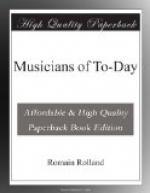Time does not exist for Don Perosi. When he courteously wished to praise French musicians, the first name he chose—as if it were that of a contemporary—was that of Josquin, and then that of Roland de Lassus, who seems to him so great and profound a musician that he admires him most of all. And Don Perosi’s universality of style is a trait that is Catholic as well as Italian. He expresses his mind quite clearly on the subject. “Great artists formerly,” he says, “were more eclectic than ourselves, and less fettered by their nationalities. Josquin’s school has peopled all Europe. Roland has lived in Flanders, in Italy, and in Germany. With them the same style expressed the same thought everywhere. We must do as they did. We must try to recreate a universal art in which the resources of all countries and all times are blended.”
As a matter of fact, I do not think this is quite correct. I rather doubt if Josquin and Roland were eclectic at all; for they did not really combine the styles of different countries, but thrust upon other countries the style that the Franco-Flemish school had just created, a style which they themselves were enriching daily. But Don Perosi’s idea deserves our appreciation, and one must praise his endeavour to create a universal style. It would be a good thing for music if eclecticism, thus understood, could bring back some of the equilibrium that has been lost since Wagner’s death; it would be a benefit to the human spirit, which might then find in the unity of art a powerful means of bringing about the unity of mind. Our aim should be to efface the differences of race in art, so that it may become a tongue common to all peoples, where the most opposite ideas may be reconciled. We should all join in working to build the cathedral of European art. And the place of the director of the Sistine chapel among the first builders is very plain.
* * * * *
Don Perosi sat down to the piano and played me the Te Deum of The Nativity, which he had written the day before. He played very sweetly, with youthful gaiety, and sang the choral parts in an undertone. Every now and then he would look at me, not for praise, but to see if we were sharing the same thoughts. He would look me well in the face with his quiet eyes, then turn back to his score, and then look at me again. And I felt a comforting calm radiating from him and his music, from its happy




